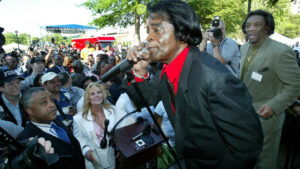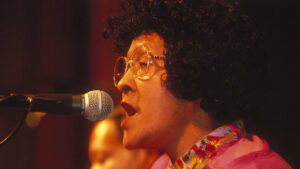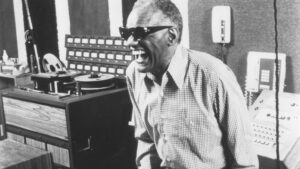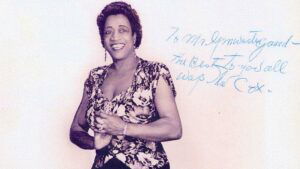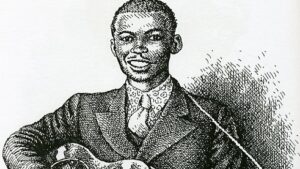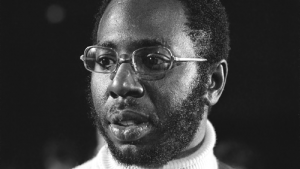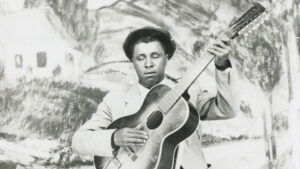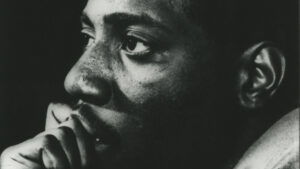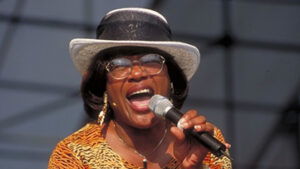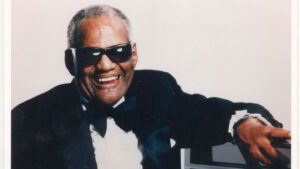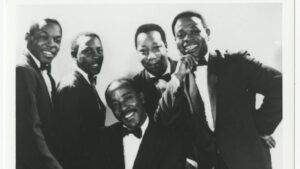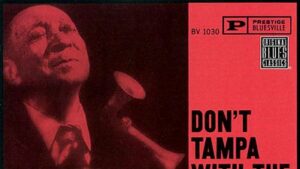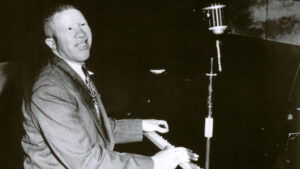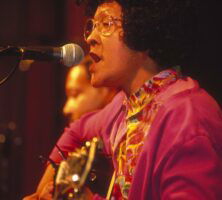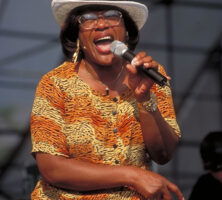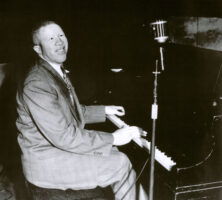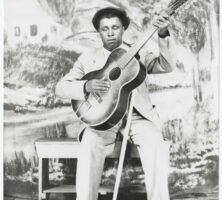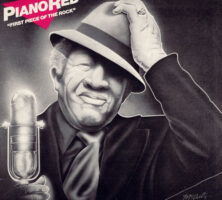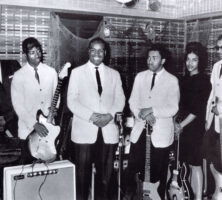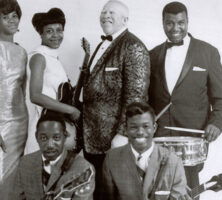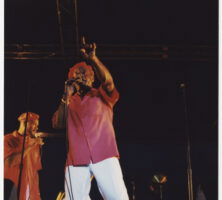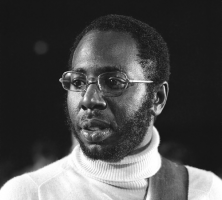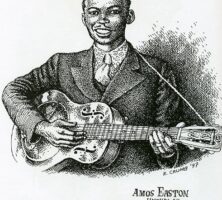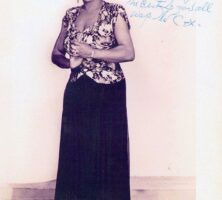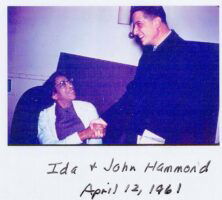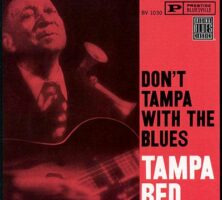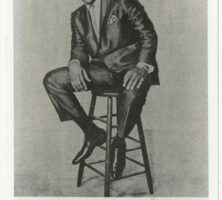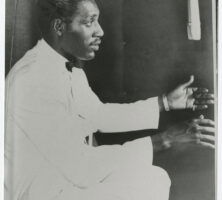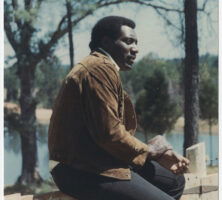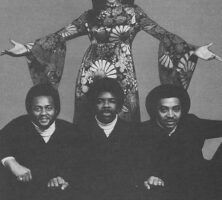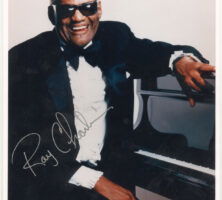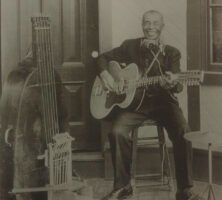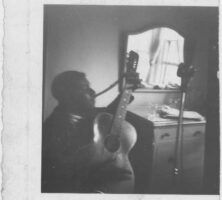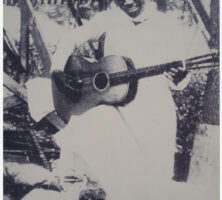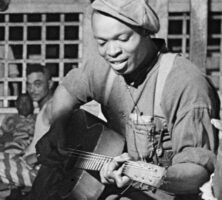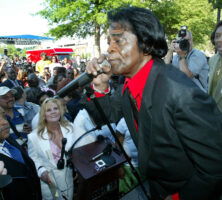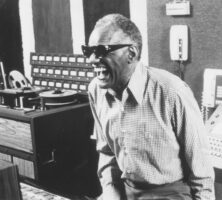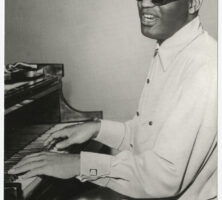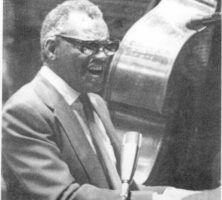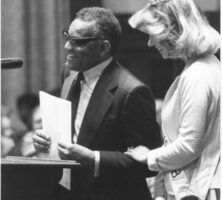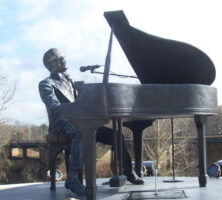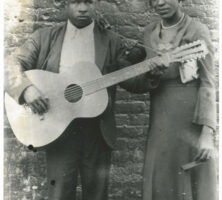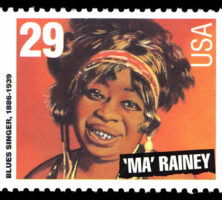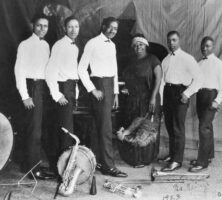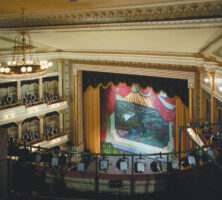The New Georgia Encyclopedia is supported by funding from A More Perfect Union, a special initiative of the National Endowment for the Humanities.
Blues musician Precious Bryant performs at the Atlanta History Center Blues Festival. Born in Talbot County in 1942, Bryant learned to play guitar as a child and began performing publicly in the 1960s.
Courtesy of Georgia Department of Economic Development.
The New Georgia Encyclopedia does not hold the copyright for this media resource and can neither grant nor deny permission to republish or reproduce the image online or in print. Requests for permission to publish or reproduce the resource may need to be submitted to the Georgia Department of Economic Development.
The New Georgia Encyclopedia does not hold the copyright for this media resource and can neither grant nor deny permission to republish or reproduce the image online or in print. All requests for permission to publish or reproduce the resource must be submitted to the rights holder.
Usher, a native of Chattanooga, Tennessee, began his recording career in 1994 with Atlanta-based LaFace Records. In 2001 the artist received two Grammy awards. Usher has also starred in several feature films.
Courtesy of Atlanta Journal-Constitution.
The New Georgia Encyclopedia does not hold the copyright for this media resource and can neither grant nor deny permission to republish or reproduce the image online or in print. All requests for permission to publish or reproduce the resource must be submitted to the Atlanta Journal-Constitution.
Francine Reed performs at Music Midtown, an annual festival in Atlanta begun in 1990s. A native of Illinois, Reed became known as Atlanta's "queen of the blues" following her move to Georgia in the early 1990s.
Courtesy of Georgia Department of Economic Development.
The New Georgia Encyclopedia does not hold the copyright for this media resource and can neither grant nor deny permission to republish or reproduce the image online or in print. Requests for permission to publish or reproduce the resource may need to be submitted to the Georgia Department of Economic Development.
Willie Lee, or "Piano Red," Perryman was a blues pianist who played in the barrelhouse style. His professional music career began in the early 1930s and continued until the late 1960s.
Photograph from booklet "Piano Red, Dr. Feelgood," by Norbert Hess
The New Georgia Encyclopedia does not hold the copyright for this media resource and can neither grant nor deny permission to republish or reproduce the image online or in print. All requests for permission to publish or reproduce the resource must be submitted to the rights holder.
Blind Willie McTell, a native of Thomson, was a great blues musician of the 1920s and 1930s. Based in Atlanta, he displayed an extraordinary range on the twelve-string guitar.
The New Georgia Encyclopedia does not hold the copyright for this media resource and can neither grant nor deny permission to republish or reproduce the image online or in print. Requests for permission to publish or reproduce the resource should be submitted to the Hargrett Manuscript and Rare Book Library at the University of Georgia.
First Piece of the Rock was released in 1983 as a tribute to Willie Lee Perryman, a blues musician known as "Piano Red" for much of his career. Two of Perryman's songs, "Rockin' with Red" and "Red's Boogie," were recorded in Atlanta in 1950 and made the national charts.
Print by Mike McCarty. Courtesy of Lowery Group
The New Georgia Encyclopedia does not hold the copyright for this media resource and can neither grant nor deny permission to republish or reproduce the image online or in print. All requests for permission to publish or reproduce the resource must be submitted to the rights holder.
Willie Lee Perryman, a blues pianist, created the Dr. Feelgood persona for his WAOK radio show, and he performed under the name with his band, the Interns. From left, Perryman, Curtis Smith, Bobby Lee Tuggle, Roy Lee Johnson, Beverly Watkins, and Howard Hobbs.
Photograph from booklet "Piano Red, Dr. Feelgood," by Norbert Hess
The New Georgia Encyclopedia does not hold the copyright for this media resource and can neither grant nor deny permission to republish or reproduce the image online or in print. All requests for permission to publish or reproduce the resource must be submitted to the rights holder.
Willie Lee Perryman, also known as "Dr. Feelgood," poses in the early 1960s with his band, the Interns.
Photograph from booklet "Piano Red, Dr. Feelgood," by Norbert Hess
The New Georgia Encyclopedia does not hold the copyright for this media resource and can neither grant nor deny permission to republish or reproduce the image online or in print. All requests for permission to publish or reproduce the resource must be submitted to the rights holder.
The Tams, a rhythm-and-blues vocal quintet from Atlanta, made their first recording in 1960. With a series of hits on the Billboard charts during the following decade, the group defined what is known as the "beach music" sound.
The New Georgia Encyclopedia does not hold the copyright for this media resource and can neither grant nor deny permission to republish or reproduce the image online or in print. Requests for permission to publish or reproduce the resource should be submitted to the Hargrett Manuscript and Rare Book Library at the University of Georgia.
Initially formed in 1952 as the Four Dots, the Tams recorded its first album as the Tams, with five members, in 1960 and enjoyed several hits in the 1960s. The Tams continued touring for decades, even after founding member Joe Pope died in 1996.
The New Georgia Encyclopedia does not hold the copyright for this media resource and can neither grant nor deny permission to republish or reproduce the image online or in print. Requests for permission to publish or reproduce the resource should be submitted to the Hargrett Manuscript and Rare Book Library at the University of Georgia.
Curtis Mayfield began his career as a professional musician at age sixteen. His longtime affiliation with a vocal group called the Impressions was followed by a series of successful and influential solo projects. Today Mayfield is revered by many for his pioneering work in the soul and funk genres.
Image from Wikimedia
The New Georgia Encyclopedia does not hold the copyright for this media resource and can neither grant nor deny permission to republish or reproduce the image online or in print. All requests for permission to publish or reproduce the resource must be submitted to the rights holder.
Propelled by two chart-climbing singles, Toni Braxton achieved stardom before the release of her first full-length record. When the rhythm-and-blues singer's debut album, Toni Braxton, finally came out in 1993, it sold more than 9 million copies.
Courtesy of Hargrett Rare Book and Manuscript Library, University of Georgia Libraries, Georgia Music Hall of Fame Collection.
The New Georgia Encyclopedia does not hold the copyright for this media resource and can neither grant nor deny permission to republish or reproduce the image online or in print. Requests for permission to publish or reproduce the resource should be submitted to the Hargrett Manuscript and Rare Book Library at the University of Georgia.
Isaac Hayes, credited with developing the "Memphis soul" sound in the 1960s and 1970s, was inducted into the Georgia Music Hall of Fame in 1994. A Tennessee native, Hayes lived in Atlanta from the mid-1970s until 1992.
Courtesy of www.isaachayes.com
The New Georgia Encyclopedia does not hold the copyright for this media resource and can neither grant nor deny permission to republish or reproduce the image online or in print. All requests for permission to publish or reproduce the resource must be submitted to the rights holder.
Isaac Hayes, an innovative soul musician, greets onlookers along the red carpet at the 2004 Turner Broadcasting System's Trumpet Awards, held at the Omni Hotel in Atlanta. Hayes began as a rhythm-and-blues musician in Memphis, Tennessee, before establishing himself as a soul musician with the 1969 album Hot Buttered Soul.
Courtesy of Atlanta Journal-Constitution.
The New Georgia Encyclopedia does not hold the copyright for this media resource and can neither grant nor deny permission to republish or reproduce the image online or in print. All requests for permission to publish or reproduce the resource must be submitted to the Atlanta Journal-Constitution.
The New Georgia Encyclopedia does not hold the copyright for this media resource and can neither grant nor deny permission to republish or reproduce the image online or in print. All requests for permission to publish or reproduce the resource must be submitted to the rights holder.
Soul musician Isaac Hayes performs in 2003 at Philips Arena (later State Farm Arena) in Atlanta during an NBA All-Star event.
Courtesy of Atlanta Journal-Constitution.
The New Georgia Encyclopedia does not hold the copyright for this media resource and can neither grant nor deny permission to republish or reproduce the image online or in print. All requests for permission to publish or reproduce the resource must be submitted to the Atlanta Journal-Constitution.
Bumble Bee Slim Easton, a native of Brunswick, became a prominent blues musician in Chicago, Illinois, where he recorded more than 150 songs during the 1930s.
Courtesy of Hargrett Rare Book and Manuscript Library, University of Georgia Libraries, Georgia Music Hall of Fame Collection.
The New Georgia Encyclopedia does not hold the copyright for this media resource and can neither grant nor deny permission to republish or reproduce the image online or in print. Requests for permission to publish or reproduce the resource should be submitted to the Hargrett Manuscript and Rare Book Library at the University of Georgia.
Ida Cox, a Georgia native, began her career as a vaudeville performer. She recorded her first blues songs in 1923 for the Paramount label, which dubbed her the "Uncrowned Queen of the Blues." By 1929, Cox had recorded seventy-eight songs, most of which she had written herself.
The New Georgia Encyclopedia does not hold the copyright for this media resource and can neither grant nor deny permission to republish or reproduce the image online or in print. All requests for permission to publish or reproduce the resource must be submitted to the rights holder.
Ida Cox, a successful blues singer of the 1920s, meets with John Hammond some years after her 1939 performance in his From Spirituals to Swing concert for an integrated audience at Carnegie Hall in New York City. Hammond, a prominent musician and producer, worked throughout the 1930s to integrate the music business.
The New Georgia Encyclopedia does not hold the copyright for this media resource and can neither grant nor deny permission to republish or reproduce the image online or in print. All requests for permission to publish or reproduce the resource must be submitted to the rights holder.
The New Georgia Encyclopedia does not hold the copyright for this media resource and can neither grant nor deny permission to republish or reproduce the image online or in print. All requests for permission to publish or reproduce the resource must be submitted to the rights holder.
Tampa Red Whittaker, a native of Smithville, was a prominent Chicago blues musician during the 1930s and 1940s.
The New Georgia Encyclopedia does not hold the copyright for this media resource and can neither grant nor deny permission to republish or reproduce the image online or in print. All requests for permission to publish or reproduce the resource must be submitted to the rights holder.
The New Georgia Encyclopedia does not hold the copyright for this media resource and can neither grant nor deny permission to republish or reproduce the image online or in print. All requests for permission to publish or reproduce the resource must be submitted to the rights holder.
Otis Redding, a Georgia native, was an influentual rhythm-and-blues and soul musician during the 1960s. Killed in an airplane crash in 1967, Redding was posthumously honored by a statue in Macon, his hometown, and induction into both the Georgia Music Hall of Fame and the Rock and Roll Hall of Fame.
The New Georgia Encyclopedia does not hold the copyright for this media resource and can neither grant nor deny permission to republish or reproduce the image online or in print. Requests for permission to publish or reproduce the resource should be submitted to the Hargrett Manuscript and Rare Book Library at the University of Georgia.
Otis Redding, an influential soul musician, began his musical career with "Little Richard" Penniman after dropping out of high school. In 1960 he joined Johnny Jenkins and the Pinetoppers as a vocalist and recorded his first hit song, "These Arms of Mine," for Stax Records in 1962.
The New Georgia Encyclopedia does not hold the copyright for this media resource and can neither grant nor deny permission to republish or reproduce the image online or in print. Requests for permission to publish or reproduce the resource should be submitted to the Hargrett Manuscript and Rare Book Library at the University of Georgia.
Although Otis Redding achieved success as a rhythm-and-blues and soul musician during the early 1960s, he did not receive much mainstream attention until the release of his song "I've Been Loving You Too Long (To Stop Now)" in 1965. In 1967 Redding released the crossover hit "Try a Little Tenderness" and was the only soul act to appear at the Monterey Pop Festival in California.
The New Georgia Encyclopedia does not hold the copyright for this media resource and can neither grant nor deny permission to republish or reproduce the image online or in print. Requests for permission to publish or reproduce the resource should be submitted to the Hargrett Manuscript and Rare Book Library at the University of Georgia.
Otis Redding, a soul musician whose work influenced such rock acts as the Rolling Stones, achieved his single number-one recording with the release of "(Sittin' on) The Dock of the Bay." The song was released three months after Redding's death in an airplane crash on December 10, 1967.
The New Georgia Encyclopedia does not hold the copyright for this media resource and can neither grant nor deny permission to republish or reproduce the image online or in print. Requests for permission to publish or reproduce the resource should be submitted to the Hargrett Manuscript and Rare Book Library at the University of Georgia.
The U.S. Postal Service's American Music Series commemorated the life of Georgia soul musician Otis Redding in 1992.
Courtesy of Smithsonian National Postal Museum
The New Georgia Encyclopedia does not hold the copyright for this media resource and can neither grant nor deny permission to republish or reproduce the image online or in print. All requests for permission to publish or reproduce the resource must be submitted to the rights holder.
Gladys Knight and the Pips formed in 1952 and toured the "Chitlin' Circuit" throughout the 1950s. In the late 1960s and early 1970s the group recorded its biggest hits, including "I Heard It through the Grapevine" (1967) and "Midnight Train to Georgia" (1973).
The New Georgia Encyclopedia does not hold the copyright for this media resource and can neither grant nor deny permission to republish or reproduce the image online or in print. All requests for permission to publish or reproduce the resource must be submitted to the rights holder.
Gladys Knight began her solo career in the late 1980s after reuniting briefly with her family band, the Pips, earlier in the decade.
Image from John Mathew Smith
The New Georgia Encyclopedia does not hold the copyright for this media resource and can neither grant nor deny permission to republish or reproduce the image online or in print. All requests for permission to publish or reproduce the resource must be submitted to the rights holder.
As a performer and recording artist in the late 1950s and early 1960s, Ray Charles pioneered a new style of music that became known as "soul," a blend of gospel music, blues, and jazz that brought him worldwide fame.
Courtesy of Hargrett Rare Book and Manuscript Library, University of Georgia Libraries, Georgia Music Hall of Fame Collection.
The New Georgia Encyclopedia does not hold the copyright for this media resource and can neither grant nor deny permission to republish or reproduce the image online or in print. Requests for permission to publish or reproduce the resource should be submitted to the Hargrett Manuscript and Rare Book Library at the University of Georgia.
In 1956 disc jockey and social activist Zenas Sears established the Atlanta radio station WAOK, one of the first in the country to play blues, rhythm and blues, and soul music as the primary format.
Courtesy of Special Collections & Archives, Georgia State University Library, Lane Brothers Commercial Photographers Photographic Collection.
The New Georgia Encyclopedia does not hold the copyright for this media resource and can neither grant nor deny permission to republish or reproduce the image online or in print. Requests for permission to publish or reproduce the resource should be submitted to Special Collections and Archives at Georgia State University.
James Brown, pictured with Aretha Franklin, was instrumental in pioneering soul music, a dynamic blend of gospel and rhythm and blues. Two of Brown's singles in 1965, "Papa's Got a Brand New Bag-Part 1" and "I Got You (I Feel Good)," were milestones of the genre.
The New Georgia Encyclopedia does not hold the copyright for this media resource and can neither grant nor deny permission to republish or reproduce the image online or in print. All requests for permission to publish or reproduce the resource must be submitted to the Atlanta University Center Robert W. Woodruff Library and Archives Research Center.
Jonesboro native Jesse Fuller became a one-man blues band. He played twelve-string guitar, harmonica, cymbals, and a foot-operated bass. The San Francisco-based rock group the Grateful Dead covered some of Fuller's songs in the 1970s and 1980s.
From The Story of the Blues, by P. Oliver
The New Georgia Encyclopedia does not hold the copyright for this media resource and can neither grant nor deny permission to republish or reproduce the image online or in print. All requests for permission to publish or reproduce the resource must be submitted to the rights holder.
Pictured in an Atlanta hotel room in 1940, "Blind Willie" McTell holds a twelve-string guitar. He recorded many blues classics, including "Statesboro Blues." McTell was the only bluesman to remain active in Atlanta (in the Decatur Street district) well after World War II.
Courtesy of Library of Congress, Prints and Photographs Division, Lomax Collection.
The New Georgia Encyclopedia does not hold the copyright for this media resource and can neither grant nor deny permission to republish or reproduce the image online or in print. All requests for permission to publish or reproduce the resource must be submitted to the rights holder.
Barbecue Bob Hicks played a distinct style of country blues with his brother, Charlie, in Atlanta in the late 1920s.
The New Georgia Encyclopedia does not hold the copyright for this media resource and can neither grant nor deny permission to republish or reproduce the image online or in print. Requests for permission to publish or reproduce the resource should be submitted to the Hargrett Manuscript and Rare Book Library at the University of Georgia.
Buddy Moss played a Piedmont style of country blues in Atlanta in the late 1920s and early 1930s. In his book The Story of the Blues, Paul Oliver describes Moss as "a link between Blind Blake and Blind Boy Fuller."
Courtesy of Library of Congress, Prints and Photographs Division, Photograph by Jack Delano.
The New Georgia Encyclopedia does not hold the copyright for this media resource and can neither grant nor deny permission to republish or reproduce the image online or in print. All requests for permission to publish or reproduce the resource must be submitted to the rights holder.
In May 2005 the city of Augusta honored James Brown with a statue of his likeness. At the unveiling ceremony, the star performed a few of his most popular songs for a crowd of fans. In attendance, standing front and center, was the Reverend Al Sharpton, Brown's former road manager.
Courtesy of Atlanta Journal-Constitution.
The New Georgia Encyclopedia does not hold the copyright for this media resource and can neither grant nor deny permission to republish or reproduce the image online or in print. All requests for permission to publish or reproduce the resource must be submitted to the Atlanta Journal-Constitution.
James Brown, known as the "Godfather of Soul" and "Soul Brother Number One," influenced a generation of younger singers with his energetic performances and distinctive vocal style. Active in the civil rights movement of the 1960s, Brown continued to speak out about racism during his long career.
The New Georgia Encyclopedia does not hold the copyright for this media resource and can neither grant nor deny permission to republish or reproduce the image online or in print. All requests for permission to publish or reproduce the resource must be submitted to the Atlanta University Center Robert W. Woodruff Library and Archives Research Center.
Ray Charles developed his signature sound of expressive piano playing and rough vocals during the 1950s. The contrasting vocals of the Raeletts, the female backup singers who joined the band in 1957, were another important hallmark of his style.
Courtesy of Hargrett Rare Book and Manuscript Library, University of Georgia Libraries, Georgia Music Hall of Fame Collection.
The New Georgia Encyclopedia does not hold the copyright for this media resource and can neither grant nor deny permission to republish or reproduce the image online or in print. Requests for permission to publish or reproduce the resource should be submitted to the Hargrett Manuscript and Rare Book Library at the University of Georgia.
Ray Charles began his professional career at age fifteen, playing in Jacksonville and Orlando, Florida. He later relocated to the West Coast to pursue better career opportunities, moving first to Seattle in 1948 and then to Los Angeles in 1950.
The New Georgia Encyclopedia does not hold the copyright for this media resource and can neither grant nor deny permission to republish or reproduce the image online or in print. Requests for permission to publish or reproduce the resource should be submitted to the Hargrett Manuscript and Rare Book Library at the University of Georgia.
Musician Ray Charles plays the piano and sings "Georgia on My Mind" for the Georgia General Assembly on March 7, 1979. The legislature later voted to make the song the official state song of Georgia.
Courtesy of Hargrett Rare Book and Manuscript Library, University of Georgia Libraries, Georgia Music Hall of Fame Collection.
The New Georgia Encyclopedia does not hold the copyright for this media resource and can neither grant nor deny permission to republish or reproduce the image online or in print. Requests for permission to publish or reproduce the resource should be submitted to the Hargrett Manuscript and Rare Book Library at the University of Georgia.
Ray Charles addresses the Georgia Legislature in 1979, after his rendition of "Georgia On My Mind," a number-one hit in 1960, was named the official state song of Georgia.
Courtesy of Hargrett Rare Book and Manuscript Library, University of Georgia Libraries, Georgia Music Hall of Fame Collection.
The New Georgia Encyclopedia does not hold the copyright for this media resource and can neither grant nor deny permission to republish or reproduce the image online or in print. Requests for permission to publish or reproduce the resource should be submitted to the Hargrett Manuscript and Rare Book Library at the University of Georgia.
Ray Charles Plaza, part of Albany's Flint River Walk, opened in December 2007 to honor musician Ray Charles. The plaza includes a bronze rotating statue of Charles, created by sculptor Andy Davis; a surrounding waterfall; and walkways engraved to look like piano keys.
Photograph by Meg Inscoe
The New Georgia Encyclopedia does not hold the copyright for this media resource and can neither grant nor deny permission to republish or reproduce the image online or in print. All requests for permission to publish or reproduce the resource must be submitted to the rights holder.
After learning to play guitar in Statesboro, blues musician "Blind Willie" McTell traveled a circuit that included Atlanta, Augusta, Savannah, and Macon during the 1920s and 1930s.
The New Georgia Encyclopedia does not hold the copyright for this media resource and can neither grant nor deny permission to republish or reproduce the image online or in print. Requests for permission to publish or reproduce the resource should be submitted to the Hargrett Manuscript and Rare Book Library at the University of Georgia.
A twenty-nine-cent stamp portrays Georgia native and blues queen Gertrude "Ma" Rainey.
Courtesy of Hargrett Rare Book and Manuscript Library, University of Georgia Libraries, Georgia Music Hall of Fame Collection.
The New Georgia Encyclopedia does not hold the copyright for this media resource and can neither grant nor deny permission to republish or reproduce the image online or in print. Requests for permission to publish or reproduce the resource should be submitted to the Hargrett Manuscript and Rare Book Library at the University of Georgia.
Gertrude "Ma" Rainey (center) made an incredible impression before she even began singing, with her thick straightened hair sticking out all over, her huge teeth capped in gold, an ostrich plume in her hand, and a long triple necklace of shining gold coins sparkling against her sequined dress.
Image from Wikimedia
The New Georgia Encyclopedia does not hold the copyright for this media resource and can neither grant nor deny permission to republish or reproduce the image online or in print. All requests for permission to publish or reproduce the resource must be submitted to the rights holder.
The restored Springer Opera House in Columbus, built in 1871, is the official state theater of Georgia.
Courtesy of Springer Opera House
The New Georgia Encyclopedia does not hold the copyright for this media resource and can neither grant nor deny permission to republish or reproduce the image online or in print. All requests for permission to publish or reproduce the resource must be submitted to the rights holder.


